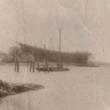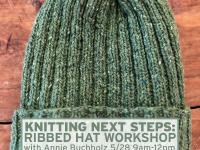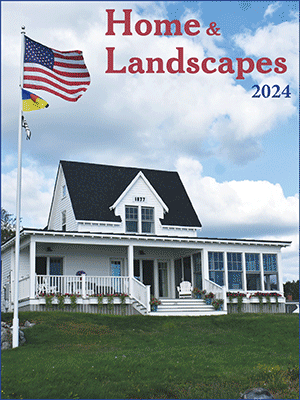The house that got away
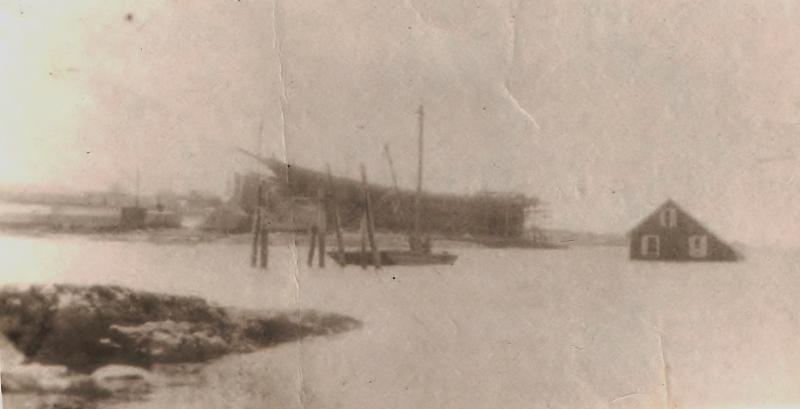 This April 1920 view shows the Machon house bobbing its way out of Mill Cove on its unmanned voyage to Tumbler Island. Small scows, such as that by the pilings, were fairly common. Perhaps it's the leaking one that set the house free, though it looks too small for half a house. The vessel being built on the shore of McFarlands Point at the Atlantic Coast Company is the 4-masted schooner James W. Howard, launched July 5, 1920. Courtesy of Lucille Machon
This April 1920 view shows the Machon house bobbing its way out of Mill Cove on its unmanned voyage to Tumbler Island. Small scows, such as that by the pilings, were fairly common. Perhaps it's the leaking one that set the house free, though it looks too small for half a house. The vessel being built on the shore of McFarlands Point at the Atlantic Coast Company is the 4-masted schooner James W. Howard, launched July 5, 1920. Courtesy of Lucille Machon
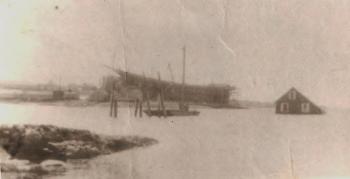 This April 1920 view shows the Machon house bobbing its way out of Mill Cove on its unmanned voyage to Tumbler Island. Small scows, such as that by the pilings, were fairly common. Perhaps it's the leaking one that set the house free, though it looks too small for half a house. The vessel being built on the shore of McFarlands Point at the Atlantic Coast Company is the 4-masted schooner James W. Howard, launched July 5, 1920. Courtesy of Lucille Machon
This April 1920 view shows the Machon house bobbing its way out of Mill Cove on its unmanned voyage to Tumbler Island. Small scows, such as that by the pilings, were fairly common. Perhaps it's the leaking one that set the house free, though it looks too small for half a house. The vessel being built on the shore of McFarlands Point at the Atlantic Coast Company is the 4-masted schooner James W. Howard, launched July 5, 1920. Courtesy of Lucille Machon
My interest in local history began with housemoving in 1986. Two well-known local house-movers from the 1910s to the 1950s were brothers Elbridge and Milton Giles, who followed in their father's housemoving steps.
The brothers initially moved houses and carried out other heavy construction projects together, then separately after about 1920. Their work years stretched from the age of oxen and horses into the age of trucks, dozers and loaders.
Horse-powered windlasses (technically capstans), rollers, rope and muscle did the job just fine before the combustion engine. In the late 1980s, Milton Giles's oldest of nine sons, Red Giles, helped me record the many houses he, his family and others moved.
Red Giles's story of the Machon move
Red started working for his father in 1927 as a 15-year-old, after being outfitted with new overalls, shoes, thermos and lunchbox. Red's first official job was moving the West Side (Southport) school, now the firehouse. The crew generally got 50 cents an hour and worked a 6-day week, though Red's youth and inexperience may have affected his pay at first.
Red's 1996 death brought our many history projects to an end. I still never pass up the opportunity to write about the wanderings of Boothbay houses.
So what follows is Red's account of the moving of the house Lucille Machon lives in near Mill Cove. It is just left or west of the large one at the end of Giles Place, recently Bob and Pat Giles Adams' house. I know of six buildings moved onto that short street, including the Adams house.
In April 1920, Milton Giles and his crew brought the present Machon house from Squirrel Island where it had been the Peterson cottage at Spring Cove.
The house came complete with a Steinway piano and other furnishings, according to Lucille. It was troublesome to move since one of the two scows, borrowed from Elbridge Giles and Roy Rowe, was leaking.
Upon reaching Mill Cove, Red's uncle, Ben Campbell, brought the scows and house to Elbridge Giles's dock on the west side of the cove and tied them up. The depth at the time was too shallow to bring them in to the shore near the destination on the east side of the cove.
Ben went back to the Milton Giles place on Giles Hill in Boothbay, where he was living, to get more rope. He planned to swing the scows and house around to the right spot when the tide came in.
The house slides away
However, when Ben got back to Giles Hill, he went to bed instead. As the tidewater rose, the leaking scow didn't come up and the house slid into the water. It floated straight out to Tumbler Island (a mile and a quarter south) where it finally sank up to the attic windows. Harold Seavey put a line on it to keep it under control.
At that time the peninsula was fairly treeless, since the region was still in the wooden age, though wooded stretches were fast growing in. One could see from the Giles place on Giles Hill all the way south down to Thad Reed's, later Spignesi, and now the new Arthur Reed place.
There was a rare telephone there, and someone called there from West Harbor to try to get the message to Milton Giles that the house was overboard. Neighbor Bertha Sherman, at the present Barry Sherman place south of Thad's, walked the near mile north and said, “Mr. Giles, your house went out to sea.”
The house eventually was towed back to its destination, after payment to Harold Seavey for his help. It then sat on the Mill Cove flats for some time. According to Lester Barter the jacking operation to raise it onto the bank created deep holes in the flats that nearly drowned his aunt. I assume she was gathering saltwater greens, as the family often did before the cove became fairly toxic.
Once the house was high and dry on Giles Place, Ben Campbell owned it as a rental; his home was where Jolly Arsenault lives on Eastern Avenue. Lots of houses were moved over water, but this is the only local one I can think of with a will of its own.
Event Date
Address
United States


